|
Who’s worth more, inventors or footballers?
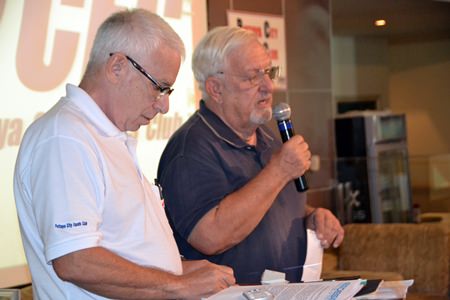
Club Member Roger Fox, who
keeps his eye out for bargain ship cruises, announces two upcoming cruises
that are good bargains that can be found on the website Vacations to Go.
Based on his past recommendations several PCEC members have joined Roger on
some delightful and economical luxury cruises.
We live in a world where inventors are often not
recognised while footballers make millions of dollars. This was one of the
messages conveyed by Stuart Saunders, an inventor himself, and long-time
PCEC member, when he spoke to the Pattaya City Expats Club on Sunday,
November 2. Stuart said that many inventors face an uphill struggle
marketing their inventions and being adequately remunerated for them. Stuart
Saunders is an Australian who has been inventing since the age of 11 (a
stereo crystal set). He is a former PCEC Vice-Chairman.
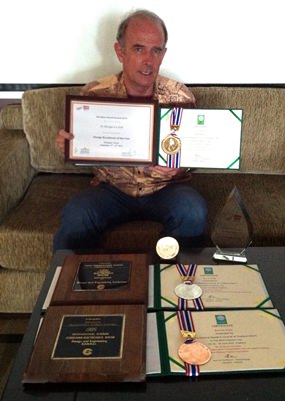
Stuart shows some of his many
awards for inventions; including selection for the CES Design and
Engineering Exhibition twice, the Award for Engineering Excellence at the
2013 World Metro Summit in Shanghai, and Bronze, Silver & Gold Medals at the
recent Thailand Inventors Award.
Stuart told the story of John Spinello who invented an electric board game
called “Operation.” The object of the game, as explained on the website
www.iloveoperation .com, was to insert a metal wand into holes in the top
layer of the board without touching the edges of the openings. If you failed
to have a steady hand, a buzzer would sound and “startle you with great
delight.” In 1964, John Spinello sold his game to an invention firm for
$500. Stuart said that the game became very successful, generating profits
of $40 million for the manufacturer. But Spinello never received another
penny. Fifty years later, Spinello is in need of an “operation” (not the
board game, but rather a medical procedure) and is having trouble coming up
with the money to pay for it.
He also told the story of Edwin H. Armstrong, an American who invented FM
radio among other things. Armstrong was involved for years in a dispute with
RCA concerning his FM radio invention, ultimately resulting in his suicide.
He added that the company eventually settled with Armstrong’s widow. Stuart
also mentioned an American man who invented a dental flossing device that
represented a significant advance in flossing but whose invention was
suppressed and dismissed by a media giant with ties to a company that was
then a dominant player in the flossing industry; and an Australian man who
invented a solution to software piracy, and patented it, and whose invention
was promptly stolen by a major software company. The man sued the company
for millions of dollars. The case was eventually settled out of court.
 Stuart
describes his plan for a ‘Pattaya Bypass’ on the east side of Pattaya, free
of traffic lights that would provide double the capacity of Sukhumvit Road,
with traveling times of 5 minutes from the Floating Market to Highway 7. “A
lot of the road already exists,” said Saunders. Stuart
describes his plan for a ‘Pattaya Bypass’ on the east side of Pattaya, free
of traffic lights that would provide double the capacity of Sukhumvit Road,
with traveling times of 5 minutes from the Floating Market to Highway 7. “A
lot of the road already exists,” said Saunders.
Stuart described some of his own inventions, including a suspension system
which duplicated the functions of the complicated and expensive Mini
rear-end in a single moving part for Minis; a number of differentials and
four-wheel drive systems; and a wireless stereo system. Stuart said that
Sony representatives expressed considerable interest in the stereo system,
but then became impossible to contact; and that the European Patent Office
rejected his application for a patent.
While living in Taiwan, Stuart designed a “Yangmingshan MRT Line,” an urban
maglev line to serve almost all of Taipei, particularly the least well
served areas. For this design, he received the ‘Award for Engineering
Excellence’ at the 2013 World Metro Summit in Shang Hai. But although the
line would have significantly cut commute times for people going from
Yangmingshan to the centre of Taipei, it was never built because of
opposition from special interests, including some people in the media.
In July this year, Stuart won bronze, silver and gold medals at Thailand
Inventors Day - for Pattaya Bypass (Bronze), FlossFirst (Silver) and the
KhaoLarmAtorium (Gold). The KhaoLarmAtorium is a cooker for Khao Larm, the
delicious Thai desert of sweet sticky rice and beans with coconut milk,
cooked in a length of bamboo. The KhaoLarmAtorium reduces CO2 emission by
over 99% by using less than 2kg of fuel vs. the 250kg of coconut husk for
the traditional method. Stuart said he is CO2 negative to the order of
approximately 10 tonnes per month just because a few friends are using his
cooker. For information on Stuart’s Pattaya Bypass proposal, visit the
website of the Pattaya Progress Association at
http://pattayaprogress.org/roads/pattaya-bypass.html.
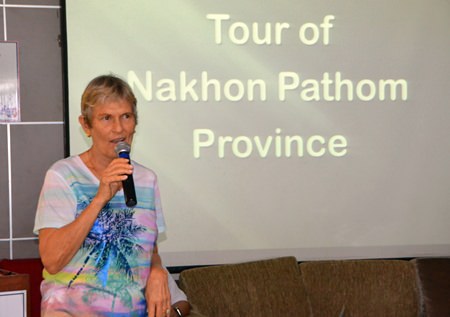
Pat Koester reminds PCEC
members that the travel agent needs their hotel deposits by November 16 for
those signing up for the two day trip to Nakhon Pathon Province on December
2 and 3rd.
Stuart said that inventors face a lot of obstacles,
including (1) the time and money it takes to get an invention to market; (2)
a corrupt patent system; (3) companies that steal your inventions; and (4) a
patent law that is difficult and expensive to navigate and that doesn’t give
inventors a say. “Too many people take inventors for granted,” Stuart said.
“If inventors are not allowed to thrive, our planet may become unlivable.”
Further, the patent system needs to be reformed.
He concluded his presentation by stating he had prepared a model patent act
that he calls the “One Dollar Patent Act 2014.” The Act states that its
purpose is “To ensure maximum chance of success for Inventions/ ... To allow
Inventors to devote maximum assets and energies to realizing a successful
Invention, ... minimal demands shall be levied on Inventors and their assets
by the patent process before commercialization…”
After Stuart’s presentation, MC Richard Silverberg updated everyone on Club
activities and upcoming events, then called on Roy Albiston to conduct the
Open Forum where questions are asked and answered about Expat living in
Thailand, especially Pattaya.
For more information on the PCEC’s many activities, visit their website at
www.pcecclub.org.
|

|
YWCA, PBTA donate food, rice to ATCC
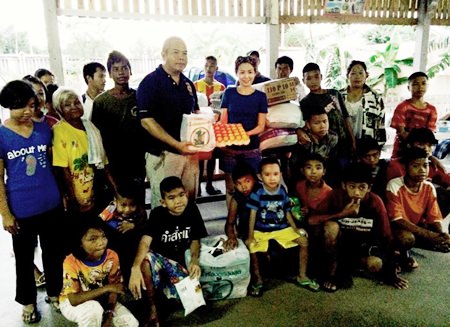
Members of the YWCA
Bangkok-Pattaya Center and Pattaya Business & Tourism Association donate rice
and dried food to the Antihuman Trafficking and Child Abuse Centre.
Jetsada Homklin
The YWCA Bangkok-Pattaya Center and Pattaya Business & Tourism
Association donated rice and dried food to the Antihuman Trafficking and Child
Abuse Centre to alleviate hardships caused by flooding there.
PBTA President Sinchai Wattanasartsathorn presented the donations to YWCA
Chairwoman Praichit Jetpai, who presented the 16,000 baht in rice, food and
other necessities to the center, which was damaged by runoff from several recent
storms.
Praichit thanked Sinchai for the group’s efforts.
Further donations of rice, dried food or daily necessities are always
appreciated. Contact CPDC at 081-411-1750.
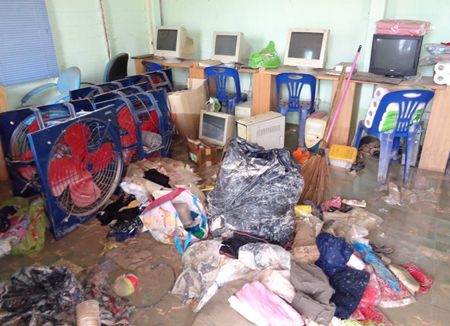
The Antihuman Trafficking and
Child Abuse Centre also suffered from the recent floods.

Pattaya Sports Club are delighted to be able
to help with the new home of Hand to Hand
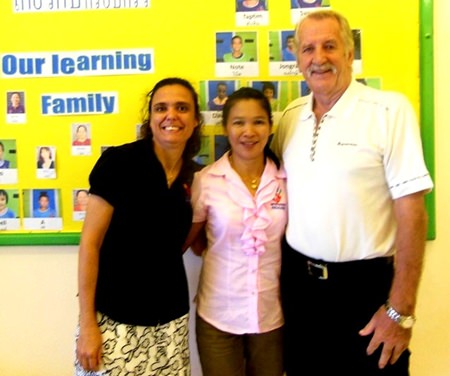
Margaret and Pai are happy - and
why not?
William Macey
Duck Square, situated behind Big C South, is virtually deserted with the
exception of a few sites that have immediate access to external roads around the
site. But that does not stop cars and motorbikes using the internal roads as a
shortcut and, usually, too quickly.
The children that attend Hand To Hand day-care centre are of pre-school age and
live on construction sites and various slums in the area. Pre-school centres are
essential to families who have very little income. The older children go to
school but what happens to those under 5 years? One of the parents must stay at
home to take care of them preventing that parent from working thereby helping
the family’s finances, hence the importance of centres similar to Hand To Hand.
Margaret and Pai run the pre-school Hand To Hand in Duck Square and have two
major concerns. The safety of the young children that attend their centre just
in case they venture onto the roads and secondly, bearing in mind the amount of
development going on in Pattaya, at any time the owners could decide to reduce
the buildings to rubble and develop what is a very large area. For some time
they have been looking for an alternative building that could accommodate 60
children during the day with the issue of safety paramount in their minds.

The centre in Duck Square was very
small.
They have recently found the perfect location in the Khopai
area of Pattaya with no busy roads to concern them and has everything that is
needed to take care of the children. Reconstruction is now complete with ample
toilet facilities, a kitchen, store areas and an external, grass covered, play
area. Margaret, having been a teacher previously, has called on all her
experience to have a medical room and separate areas where the children can
learn to read and write to prepare them for the 10 years or so they will spend
in school. The end result is a happy, colourful centre where the children can
enjoy a really nice day.
Donations have been made by a number of companies and individuals including
Pattaya Sports Club who have provided funds to enable them to buy items that are
needed: desks, toys, air conditioning and various items for storage.
Margaret and Pai never have a moment to themselves for, in addition to the day
care centre, they visit the local prison three times per week to help those
families that need help and make regular visits to the local slums. If you feel
that you would like to make a contribution in any way, please contact William on
0861522754 or Margaret on 0890936067. Every little bit helps.
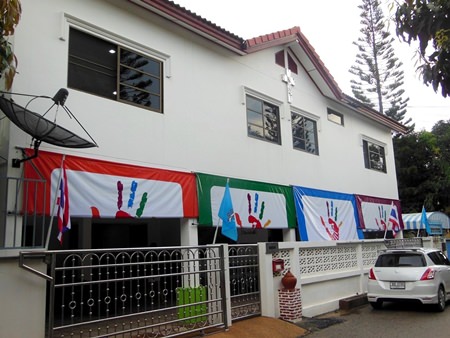
The new centre is big and spacious.

Here, volunteers are teaching the children to read
and write.
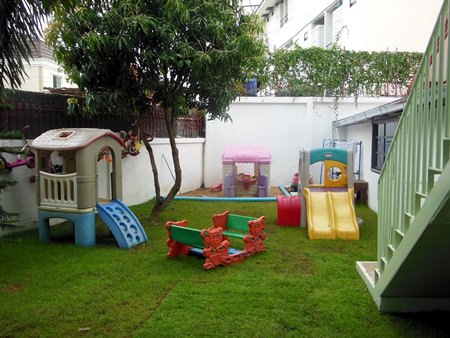
There is a play area which is now safe from any
traffic.

Sleep comes easy to young
children.

The children say thank you to all
the sponsors.
|

|
A long way from home

Sister Pavinee greets the mothers
who travelled to Pattaya with their children.
Derek Franklin
Earlier this year Reuters, the international news agency, reported that
in the past decade almost six thousand people have been killed in the insurgency
taking place in the southern provinces of Thailand.
Many more, Buddhists and Muslims, have been wounded, or left with a disability,
and while there are rehabilitation and educational facilities for people with a
disability living in the south, they are not of a similar standard as throughout
the rest of the Kingdom.
To offer support to those living in the south, several teachers from the
Redemptorist Vocational School for People with Disabilities in Pattaya traveled
to the provinces of Yala, Pattani and Narathwat. There they met several young
men and women who were interested in enrolling at the school.
Fifteen were accepted, and they made the long journey, over a thousand
kilometers, to Pattaya, most accompanied by their parents. Having a child so far
away from home is a worrying time for any parent, but Sister Pavinee, manager of
the school, was on hand to meet with several mothers and put their mind at ease.
These are not the first students at the school who came from the south of the
country. But as life for people with disabilities becomes more hazardous, and
the likelihood of finding a vocational education and employment is low, there is
a need for young people, with or without a disability, to gain knowledge, learn
new skills, build their confidence and become more independent.
After two years at the school they will once again make the long journey home.
But in two years time they will have the ability to live independently, join the
workforce as equals and, in the words of Father Ray Brennan, ‘earn their own
rice’.
More information can be found at www.fr-ray.org or email
[email protected]
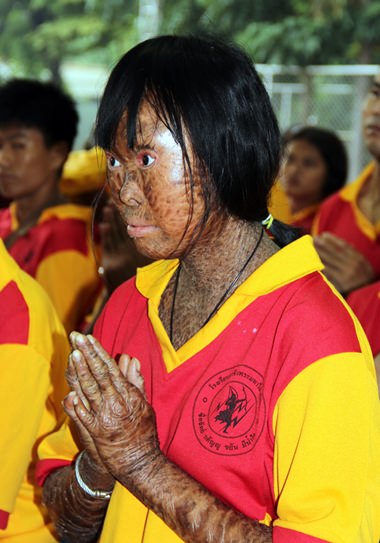
The new students received a
blessing on their first day.

Two years at the school and his
life will change forever.
|

|
|

